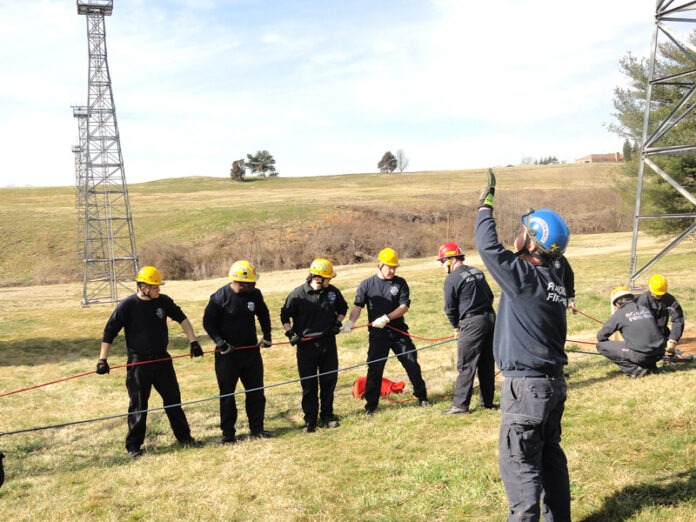
by Gene Marrano
What if an accident took place on one of those lighted towers that help guide pilots to Roanoke Regional Airport? What if a FAA worker slipped and fell, was left dangling by their safety harness, or even had a heart attack and was incapacitated? That’s a scenario Roanoke City Fire and Rescue personnel may one day have to deal with.
At the request of local Federal Administration Agency officials, the department spent several days earlier this week going through a series of training exercises, preparing for just such an occasion.
Battalion Chief Jeff Beckner watched as members of the city’s Heavy Tactical Rescue (HTR) crew worked with ropes and winches to retrieve “someone” from the top of a 70’ tall light tower just off Frontage Road near the old Countryside golf course.
The “someone” was actually a dummy, lowered to the ground after two rescue team members climbed to the top of the tower and placed it in a harness. Beckner called this particular exercise a high angle rescue.
“We just love the opportunity to work with [the FAA] and get to know them,” said Beckner of the first time training exercise. “I think we make them feel a lot safer. It was really a neat experience.”
Roanoke City Fire and Rescue trains in all types of scenarios, including collapsed buildings (which became more prevalent after 9/11 and the fall of the World Trade Center towers), swift water and confined spaces.
Beckner said there have been a few instances – maybe ten a year – where they have to perform rescues in unusual circumstances. Around 100 of the city’s fire/EMS crews are on the HTR team, split into 33 per each eight-hour shift. Team members from all three shifts took part in the training exercises with the FAA. HTR members can’t have an aversion to heights or tight spaces, according to Beckner, who has been with the department for 27 years.
Other localities in the valley have their own rescue squads and all join forces when warranted. There are also joint training exercises several times a year. Members of Roanoke’s HTR take part in a statewide “rescue challenge” exercise every year as well.
“It’s all [about] communication,” said Beckner about the rescue team, which must work with other fire/EMS squads that are often on the scene before the HTR unit can be assembled. Results of the FAA rescue exercises will be evaluated and techniques could be tweaked, according to Beckner.
Chip Baldwin, the local FAA representative, kept a watch on the HTR crews as he spoke with other members of Roanoke’s fire/EMS team. The Airways Transportation System specialist said the FAA discovered that Roanoke’s rescue teams “had a lack of information on the type of facilities that we have and the functions that they carry out.”
The FAA had worked out a series of drills (with air traffic controllers) in and around the airport with Roanoke City fire, police and dispatch personnel in the past, including disaster training on the airport grounds, but “the fire department had no clue,” said Baldwin as to what happens on light and radar towers.
Baldwin said it was important for the department to see what they do – and where the dangers are, such as workers scrambling to the top of 70’ tall towers (or higher) every few weeks. Accidents or other scenarios that would call for a rescue team have been few and far between but Baldwin said it was all about being prepared for the worst.
“They had never done a drill with us,” noted Baldwin, “and what happens if one of our technicians gets hurt? How can I help them rescue me?” That question was answered in large part by the training exercises with Roanoke City and the HTR teams. Baldwin was impressed: “they know what they’re doing [and] will be able to come get you.”
